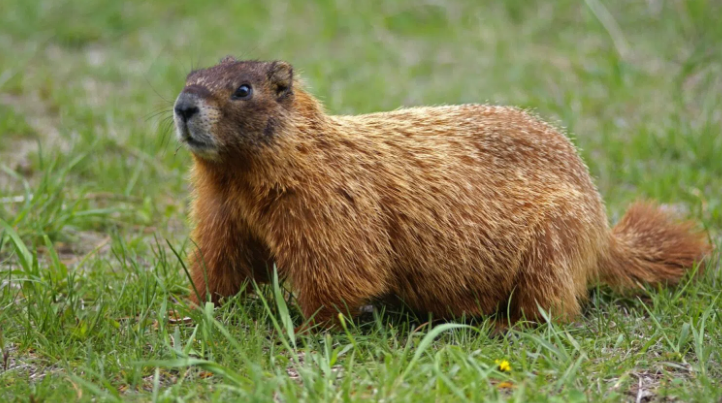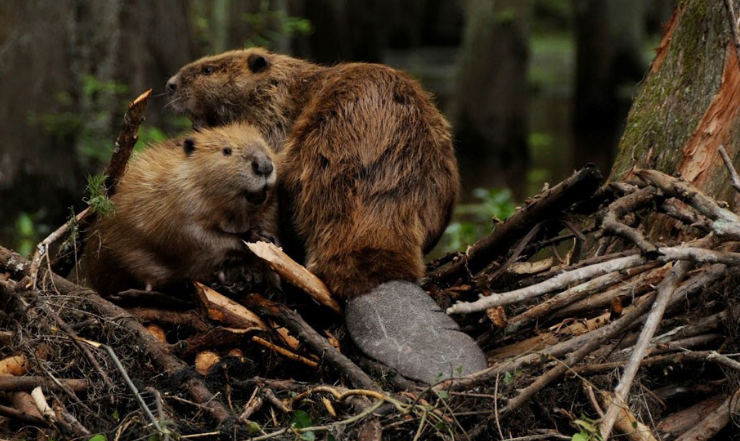Groundhog

The groundhog, also known as a woodchuck or whistle-pigs, is a rodent of the family Sciuridae, belonging to the group of large ground squirrels known as marmots.
The groundhog is a lowland creature of North America; it is found through much of the Eastern United States, across Canada and into Alaska. They most commonly live along forest edges abutting meadows, open fields, roads, and streams, but they are occasionally also encountered in dense forests.
Physically, groundhogs exhibit stout bodies with short legs, covered in brown fur that darkens with age. They have a robust build, with sharp, chisel-like teeth adapted for gnawing on plants and vegetation. They are herbivores, favoring a diet consisting of various plants, vegetables, fruits, and grasses.
Groundhogs dig intricate underground burrows, equipped with multiple entrances and chambers. These burrows serve as their homes and offer protection from predators and the elements. They are usually active during the warmer months, foraging for food and maintaining their burrows.
Groundhogs are primarily active during the daytime. Their daily activities involve sunbathing, foraging, and vigilant surveillance of their surroundings for potential threats. However, groundhogs are also known for their ability to quickly retreat into their burrows at the first sign of danger.
Although groundhogs dig deep and extensive burrow systems, they are also good swimmers and can climb tall shrubs and sizable trees. They are most active in the morning and evening, eating grasses and other green plants, as well as some fruit and the bark and buds of trees.
In terms of their social behavior, the groundhog is solitary except in the spring, when a litter of four to six young is born. (Litters of one to nine have been recorded.) The young stay with the mother for two to three months. Their lifespan in the wild ranges from 3 to 6 years.
Beaver

Beavers are large, semiaquatic rodents of the Northern Hemisphere. There are two existing species: the North American beaver and the Eurasian beaver.
Beavers are the largest rodents in North America and Eurasia and the second largest rodents worldwide. Their bodies extend up to 80 cm (31 inches) long and generally weigh 16–30 kg (35–66 pounds); however, beavers continue to grow throughout their life, and the heaviest beavers can weigh more than 50 kg (110 pounds).
Beavers have short legs and a stout body with a small, broad, and blunt head. Massive chisel-shaped incisor teeth have orange outer enamel. The teeth grow continuously throughout their lives. Beavers possess webbed hind feet and a broad, flat, scaly tail, which they use not only for swimming but also as a tool for building their iconic dams and lodges. Their fur is dark brown, dense, and waterproof, allowing them to stay warm and dry in the water.
Living in streams, rivers, marshes, and ponds and on the shorelines of large lakes, beavers construct dams of branches, stones, and mud, forming ponds that often cover many hectares. Ecologists often refer to beavers as “ecosystem engineers” because of their ability to alter the landscapes in which they live.
Their diet consists of the soft cambium layer beneath bark, as well as the buds, leaves, and twigs of certain trees (willows and aspens are preferred). Pond vegetation and bankside plants are also eaten. Herbaceous vegetation is consumed mostly during summer and woody matter during winter.
In addition to their dams, beavers build lodges, which are dome-shaped structures made from sticks, mud, and rocks. These lodges serve as their homes and offer protection from both the elements and predators. Lodges usually have underwater entrances, ensuring safe access to their burrowed interior.
Beavers are most active during the dawn and dusk hours. They are highly social animals, living in family groups known as colonies, which consist of a monogamous pair (the adults) and their offspring from previous years. These colonies work together in maintaining their dams and lodges and in caring for the young kits.
Beavers mate between January and March in the north and November or December in the south. One litter per year of one to nine (usually four) kits is born in the spring after a gestation of 105 days. Beavers communicate by postures, vocalization, scent marking, and tail slapping.
The lifespan of beavers in the wild can be from 10 to 15 years. Their activities have significant ecological impacts, from altering water flow and creating wetland habitats to influencing the growth of forests.
Groundhog vs Beaver: Key Difference
| Feature | Groundhog (Marmota monax) | Beaver (Castor canadensis) |
|---|---|---|
| Taxonomy | Groundhogs belong to the family Sciuridae (squirrel family). | Beavers belong to the family Castoridae (beaver family). |
| Habitat | Groundhogs are primarily found in burrows in open areas like fields and meadows. | Beavers inhabit freshwater environments, building dams and lodges. |
| Size | Groundhogs are smaller, typically measuring around 16-26 inches in length and weighing 4-9 pounds. | Beavers are larger, usually ranging from 24-39 inches in length and weighing 35-70 pounds. |
| Physical Appearance | Groundhogs have stout bodies with short legs, and their fur is brown with a lighter underside. | Beavers have a more streamlined appearance with webbed feet and a flat, scaly tail. Their fur is dark brown. |
| Diet | Groundhogs are herbivores, primarily feeding on plants, vegetables, and fruits. | Beavers are herbivores, mainly consuming tree bark, leaves, and aquatic plants. |
| Teeth | Groundhogs have sharp, chisel-like teeth for gnawing on plants. | Beavers have large, orange incisors adapted for cutting down trees and building dams. |
| Tail | Groundhogs have a short, bushy tail. | Beavers have a broad, flat, scaly tail used for swimming and as a tool for building. |
| Burrowing Behavior | Groundhogs dig extensive burrows with multiple entrances and chambers for hibernation and raising young. | Beavers are known for building dams and lodges made from sticks, mud, and rocks. |
| Activity Pattern | Groundhogs are diurnal, primarily active during the day. | Beavers are crepuscular and nocturnal, more active during dawn and dusk. |
| Social Structure | Groundhogs are mostly solitary animals. | Beavers live in family groups called colonies, consisting of parents and offspring. |
| Lifespan | Groundhogs typically live up to 3-6 years in the wild. | Beavers can live up to 10-15 years in the wild. |
| Geographic Distribution | Groundhogs are found in North America, mainly in the eastern and central regions. | Beavers are widespread in North America, including both North and South, and parts of Europe and Asia. |